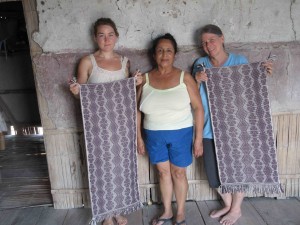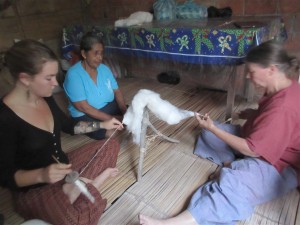A Resounding Success: 2015 Summer Textile Apprenticeship Program
The two fiber artisans that I chose to travel to Manabí province in coastal Ecuador to learn the pre-Columbian spinning and weaving techniques of the ancient Manteño and their forebearers turned out to be terrific apprentices. Janet and Amber, both hailing from northern California, quickly learned the traditional coastal Manabí methods of spinning, dyeing using fresh leaf indigo and weaving on a vertical loom. I have got to hand it to Janet and Amber—within a two week period, they accomplished a lot—producing two lovely wall hangings patterned in the traditional design of the rose and chalice. They learned how to spin cotton Ecuadorian coastal style with a horizontally held hand spindle, and how to dye with fresh leaf indigo.
Their native Ecuadorian instructors from the villages of El Zapote and the nearby town Rio Chico in central Manabí Province proved not only the exceptional artisans as I already knew them to be, but proficient teachers as well:
Doña Trinidad from El Zapote taught them how to weave a lovely wall-hanging using the patterning structure of simple alternating float weave for the design. Her older sister, doña Mariana taught the gals how to spin. And to boot, both learned the two-person warping method for a cotton hammock used by the the last hammock weaver in the nearby village of Rio Chico, Doña Honesta.
I must admit that I was unfamiliar with this way of warping for a hammock–having learned the single-person method used in Zapote, just a few kilometers down the road.
Better apprentices I couldn’t have asked for: Janet and Amber arrived eager to learn–and had actually been spinning with a hand spindle on the airplane! They also proved to be flexible and adaptable–eating the food prepared for us without complaint (even though it was very high in rice and plantain starches), and adjusting to less than luxurious living conditions. They also saw the beauty in the traditional bamboo house construction and appreciated how they lived their lives with less “stuff” cluttering the living quarters.
For additional background on this artisan tradition that I have been trying to keep alive since 2006, please check out my video, Hanging by a Thread, below:
I also undoubtedly played a role in their successful experience—functioning both as a language interpreter, going from the colloquial Spanish of these rural folk of this coastal region into “textile” English and vice versa. But I also served as a cultural interpreter–brokering the cross-cultural experiences flowing in both directions in order to insure that no-one was misunderstood or misrepresented. My training as a cultural anthropologist served me well in addition to having had a long-standing trusting relationship with this wonderful and hospitable artisan family since 1976.
Everyone had a lot of fun and benefitted in many ways. Janet and Amber returned home with a profound appreciation of this ancient spinning and weaving tradition and a willingness to help it continue into the future.
And everybody involved on the Ecuadorian end also benefitted—financially and well as gaining a new found appreciation of their own ancestral traditions of spinning and weaving. “If two gals are willing to spend a huge chunk of change on traveling from the USA to Ecuador just to learn this handicraft–it must be worth something”, they reasoned.
In this regard, the apprenticeship program of 2015 has opened the door to their realizing that this ‘old fashioned’ craft of the grandmothers might actually provide a future for a young person who is willing to learn.
We are rooting for Melina, Trinidad’s niece who will be 15 years old soon—just the perfect age to learn to weave. She already knows how to spin (see YouTube video below).
Janet and I are working on the details of providing her with a scholarship to learn. The ultimate goal is to enable her to travel to the USA with her aunt Trinidad in a couple of years to carry out some demonstrations and workshops. They both are very interested in this possibility.
As plans develop, I will keep you posted. Please share your comments. Kathleen





This was one of the most amazing experiences of my life! The cultural experience was wonderful. I loved the people we met and lived with for two weeks. Hanging out in hammocks under the house in the heat of the day was as important to me as the lessons in weaving and spinning.nmy great retreat was that I could not speak Spanish, and have more meaningful conversations. I’m looking into Spanish lessons, so I can return one day for better personal exchange. Thanks to Kathleen for the invitation and all that translating.
At home again in California I am spinning lots of cotton, And weaving on my old Navajo style loom, in Ecuadorean style. I’m workin on a piece with the salt and pepper pattern, which is much simpler and appropriate for starting out n my own.
Will there be a 2016 internship? Thx!
Hi Kathy,
I personally will not be running a 2016 workshop, but one of the students, Janet, who attended in 2015 was very taken by it and is committed to returning with students of her own to apprentice with the weavers and spinners. However, I don’t know if it will be in 2016. I kind of doubt it. Perhaps in 2017, or if there is enough interest, you might be able to convince her for an earlier date. It has to be during our summer (USA months) which is the dry season down there. Please contact her at Auntjanets1953@gmail.com to tell her of your interest. Thanks, Kathie
hola
Soy Bryan Granda, un joven tejedor, ceramista y en proceso de estudiar antropología, al ver sus vídeos, he quedado asombrado con la documentación.
sin embargo mi mayor asombro fue que en Manabí también existe la tecnica de labrado, aquí en mi ciudad existe esa técnica con mucha figuras muy bonitas que en su mayoría son flores y algunos patrones geométricos. Y no solo aprendí la técnica de labrado y llano, si no que también dos mas, llamadas reversible y realzado. Quisiera poder mostrarle toda la amplia gama de figuras que tengo, espero que lea esto y podamos contactarnos. Puede dirigirse a mí por mi correo (bryanvini_98@hotmail.com.ar) o si desea llamarme (593) 0993194902). Muchas gracias.